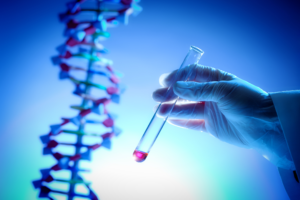Chromatography is a powerful analytical technique that plays a pivotal role in various scientific and industrial fields. From identifying the components of complex mixtures to ensuring product quality, chromatography has become indispensable in modern research and development. In this blog post, we will delve into the world of chromatography, breaking down its principles, applications, and benefits. So, let’s embark on a journey to demystify chromatography!
Chromatography is a separation technique used to separate and analyze complex mixtures into their individual components. It involves two main phases: the stationary phase and the mobile phase. The sample is introduced into the mobile phase, which carries it through the stationary phase. Components within the sample interact differently with the stationary phase, leading to their separation based on specific properties such as size, charge, and affinity.
Table of Contents
Types of Chromatography

Chromatography, a powerful analytical technique, encompasses various methods for separating complex mixtures into their individual components. By utilizing distinct principles and equipment, chromatography techniques find application across diverse scientific and industrial domains. In this article, we will explore the different types of chromatography, shedding light on their unique features and widespread usage.
Gas Chromatography (GC): Gas chromatography involves the separation of volatile compounds by passing a gaseous mobile phase through a stationary phase, such as a capillary column. This technique is widely used in environmental monitoring, food analysis, and drug testing, owing to its ability to provide precise and rapid results.
Liquid Chromatography (LC): Liquid chromatography employs a liquid mobile phase to separate non-volatile and polar compounds. This versatile technique is subdivided into various forms like High-Performance Liquid Chromatography (HPLC), Ultra-High-Performance Liquid Chromatography (UHPLC), and Reverse-Phase Liquid Chromatography (RP-LC), making it suitable for diverse applications.
High-Performance Liquid Chromatography (HPLC): HPLC is an advanced form of liquid chromatography that utilizes high-pressure pumps for faster and higher resolution separations. Its applications include pharmaceutical analysis, food quality control, and forensic investigations.
Thin-Layer Chromatography (TLC): TLC involves the separation of compounds on a thin layer of stationary phase, often coated on a glass or plastic plate. This cost-effective technique finds extensive use in drug purity checks, herbal medicine analysis, and environmental testing.
Paper Chromatography: In paper chromatography, the stationary phase is a specialized paper, and the mobile phase ascends through it by capillary action. This technique is popular for qualitative analysis and is commonly employed in educational settings for practical demonstrations.
Ion-Exchange Chromatography (IEC): IEC separates ions based on their charges. It is widely used in biochemistry and biotechnology to purify proteins and separate biomolecules.
Affinity Chromatography: Affinity chromatography exploits the specific interactions between a target molecule and a ligand attached to the stationary phase. This technique is frequently used to purify proteins, antibodies, and enzymes.
Size-Exclusion Chromatography (SEC): SEC separates molecules based on their size, allowing the analysis of macromolecules such as polymers and proteins. It is vital in the quality control of biopharmaceutical products.
Chiral Chromatography: This type of chromatography separates enantiomers, which are molecules that are mirror images of each other but differ in their biological and chemical properties. Chiral chromatography is crucial in pharmaceutical research and development.
Gas Chromatography-Mass Spectrometry (GC-MS): Combining gas chromatography with mass spectrometry, GC-MS provides both separation and identification of compounds, making it highly valuable in forensic analysis, environmental monitoring, and drug detection.
Applications of Chromatography: Unlocking the Secrets of Complex Mixtures

hromatography, a powerful analytical technique, finds widespread applications across diverse industries and scientific research fields. This method allows scientists to separate and analyze complex mixtures with high precision, sensitivity, and speed. In this blog post, we will explore the various applications of chromatography and its invaluable contributions to advancing knowledge and innovation. From pharmaceuticals to environmental analysis, chromatography continues to revolutionize industries worldwide.
Pharmaceutical Industry
In the pharmaceutical sector, chromatography plays a vital role in drug development and quality control. It helps in identifying and quantifying active pharmaceutical ingredients, ensuring the purity of formulations, and detecting impurities that may affect drug efficacy and safety.
Environmental Analysis
Environmental scientists rely on chromatography to monitor and analyze pollutants in air, water, and soil samples. By accurately identifying and quantifying these substances, researchers can assess environmental impact and implement effective mitigation strategies.
Forensic Science
In the realm of forensic science, chromatography aids in identifying substances found at crime scenes, including drugs, toxic compounds, and trace evidence. This valuable tool strengthens the process of criminal investigations and supports law enforcement agencies in solving complex cases.
Food and Beverage Industry
Chromatography is crucial in ensuring the safety and quality of food products. It helps detect and quantify additives, contaminants, and nutritional components, ensuring compliance with industry regulations and consumer protection.
Biotechnology
In biotechnology, chromatography is employed for purifying proteins and isolating DNA. This technique is integral to genetic research, the production of biopharmaceuticals, and the development of novel therapies.
Petrochemical Industry
Chromatography facilitates the analysis of petroleum products, enabling researchers to characterize and quantify hydrocarbons, sulfur compounds, and other components. This data aids in refining processes and ensures compliance with environmental regulations.
Clinical Diagnostics
In clinical settings, chromatography is utilized for diagnosing various diseases and disorders. It enables the accurate measurement of biomarkers and the identification of abnormal metabolites, aiding in disease detection and patient management.
Environmental Monitoring
Chromatography is essential for monitoring air quality by analyzing volatile organic compounds (VOCs) and atmospheric pollutants. This data helps authorities understand air pollution levels and formulate effective air quality improvement strategies.
Water Quality Assessment
Water quality assessment relies on chromatography to detect and quantify pollutants, including pesticides, heavy metals, and pharmaceutical residues. By evaluating water safety, scientists can safeguard human health and aquatic ecosystems.
Drug Testing and Toxicology
Chromatography is widely employed in drug testing and toxicology screenings, enabling the detection of drugs and metabolites in biological samples. This application is crucial in workplace drug testing, sports doping control, and forensic toxicology investigations.
Chromatography’s versatility and accuracy have made it a cornerstone in numerous industries and scientific disciplines. From pharmaceuticals and environmental analysis to forensic science and biotechnology, chromatography continues to push the boundaries of scientific discovery and application. With ongoing advancements in technology and methodology, we can expect even more innovative applications of chromatography in the future. Embrace this powerful analytical technique and unlock the hidden secrets within complex mixtures for a brighter and more informed world.
Benefits of Chromatography: Empowering Science and Industry

Chromatography, a versatile analytical technique, has revolutionized the way we explore and understand complex mixtures. Its significance spans across scientific research, industrial applications, and even forensic investigations. In this article, we will delve into the ten remarkable benefits of chromatography and explore how this powerful tool is shaping the landscape of various fields, all while unleashing the full potential of chromatography for scientific progress.
- Precision and Accuracy
Chromatography offers unparalleled precision and accuracy in separating and analyzing components within a mixture. Researchers can confidently identify and quantify even minute quantities of compounds, making it an invaluable asset in fields like pharmaceuticals and environmental analysis.
- Wide Applicability
With a diverse range of chromatographic methods available, this technique caters to the needs of various industries and scientific disciplines. From gas chromatography for volatile compounds to high-performance liquid chromatography (HPLC) for polar molecules, chromatography covers a wide spectrum of applications.
- Sensitivity
Chromatography’s sensitivity enables the detection of trace levels of substances. This quality is crucial for fields such as clinical diagnostics, where even the smallest concentration of a biomarker can lead to early disease detection and treatment.
- Speed and Efficiency
Advancements in chromatographic instrumentation have significantly reduced analysis times, promoting faster research outcomes and higher throughput in industrial settings. Scientists can now obtain results in a fraction of the time compared to traditional methods.
- Purity Assurance
In pharmaceutical and biotechnology industries, chromatography is an essential tool for ensuring the purity and quality of drugs, biologics, and other products. It helps identify and remove impurities, guaranteeing safe and effective treatments for patients.
- Environmental Monitoring
Chromatography plays a pivotal role in monitoring environmental pollutants. By accurately identifying and quantifying harmful substances in air, water, and soil samples, environmental scientists can make informed decisions to protect our planet.
- Food Safety and Quality Control
The food and beverage industry relies on chromatography to ensure the safety and quality of products. From detecting contaminants to analyzing nutritional content, this technique helps maintain high standards in the food supply chain.
- Forensic Investigations
Forensic scientists use chromatography to analyze complex mixtures found at crime scenes. The technique helps identify illicit substances, examine blood alcohol levels, and link suspects to evidence, aiding in criminal investigations.
- Research Advancements
Chromatography accelerates scientific breakthroughs by facilitating the isolation and purification of compounds, proteins, and DNA. Researchers can focus on specific elements for in-depth analysis, enabling advances in fields like genetics and proteomics.
- Cost-Effectiveness
Despite its sophisticated capabilities, chromatography offers an excellent return on investment due to its wide range of applications and accurate results. Companies and researchers can optimize resources while benefiting from its multifaceted potential.
The benefits of chromatography are far-reaching, propelling advancements in science and industry alike. Its precision, sensitivity, and versatility empower researchers and analysts to explore complex mixtures, ultimately leading to innovations that positively impact our world. From pharmaceutical development to environmental protection, chromatography continues to transform the way we understand, analyze, and optimize our surroundings, making it an indispensable tool for generations to come. Embrace the power of chromatography, and unlock the boundless possibilities it holds for a brighter and more informed future.




